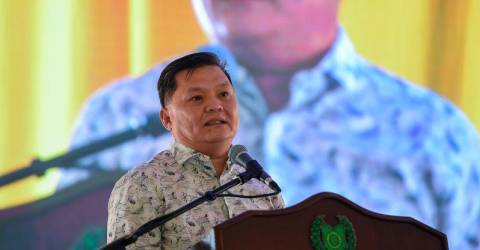ADVERTISE HERE

Asan covering himself in ‘Pua Kumbu’ during the ‘nilik semengat’ part of the ‘beserara bungai’.
THE rituals and traditions associated with death that are practised by the Ibans in Sarawak can be different from one group to another.
In Kanowit, where I hail from, there is no ‘sapat’ – an enclave formed out of a hung Pua Kumbu cloth – placed at the ‘ruai’ (common) section of a longhouse, as that practised by the Ibans in the Betong Division.
In Saratok, the remains of the dearly departed would be cleansed using only water collected from the river, which is not practised in Kanowit.
From the time of death to ‘nyengai antu’ (funeral wake), ‘nanam ulit’ (beginning of mourning period), ‘beserara bungai’ (rituals to mark separation of the dead and the living) and ‘ngetas ulit’ (end of the mourning period), each process has its own dos and don’ts that must be observed strictly and meticulously to avoid misfortune and calamities.
In an interview with Utusan Borneo in 2013, Edward Untie – a former teacher from Sungai Klampai in Saratok, who was also well-versed in Iban customs – had said that there were ‘four classifications of death’.
“First is ‘mati lulus’ of stillbirth or death of babies immediately after being born; second is ‘mati tachak’ or ‘mati ruyak’, death of single individuals without any child; third, ‘mati nganta’ or ‘mati belala’, death of married persons with children at a young age; and, fourth, ‘mati tuai’ or ‘mati pulai’, death of those at an old age.
“For every death, for example, that of a woman who died during childbirth, items such as corn seeds, lime thorns, ‘randau’ (creepers) thorns, porcupine spikes and ‘entingan’ leaves would be sprinkled over her grave.
“This is to prevent her spirit from being possessed, or turned into ‘koklir’ (female vampire).
“If a person died in old age, if he already had a great-great-great-grandchild, there would be no mourning period,” said Edward in the 2013 interview.

TR Muyan Maringgai (standing) performing the ‘bebiau’ right after the end of the ‘ngetas ulit’ ceremony.
‘Nyengai antu’
Wanting to know more about the Iban rituals associated with death, I felt that my own longhouse at Nanga Ngungun in Ngemah, Kanowit would be the best place to start.
I then made arrangements to see my cousin, Jalak Bujun, 70, one of the elders of Rumah Genam Dunggau, to know more about the subject.
Ever willing to help out, Jalak thoroughly outlined the rituals undertaken after the death of our cousin, the late Enta Jenbu.
For the record, it should be stated here that this practice is typically associated with the Iban community of Ngemah.
Enta was pronounced dead at 12.44am on June 8 last year, after being hospitalised for two days following complications from severe pneumonia.
She was 71.
Her passing was announced by her son Silo Lenggu and almost immediately, the folks at Rumah Genam made all the arrangements for the funeral.
“When a person dies outside the longhouse, a ‘genselan’ (ritual of purification) must be performed before the body is allowed to enter the longhouse.
“The ‘genselan’ would involve the slaughtering of one pig, or two chickens in the absence of a pig, and is a must to protect the longhouse from ‘angat’ (‘heat’, or in this context, misfortunes).
“We believe that misfortunes, including sickness, which could lead to death among the longhouse inhabitants, would occur continuously if we failed to observe this custom,” said Jalak.

Jalak cutting the ‘ulit’ bracelet off Enta’s daughter in law, with Genam (left) preparing to smear chicken blood on her as ‘genselan’.
Upon arrival at the longhouse, Enta’s remains were laid down on the ‘ruai’, allowing family members and relatives, friends and other longhouse residents to pay their last respects.
Placed near the body was ‘baya’, a group of personal belongings that would later be buried alongside her.
For the Ibans in Kanowit, the funeral wake would usually last for two days and two nights before burial.
During this period, family members and longhouse residents must be on guard at all times to avoid the body from being stepped on or over by cats or dogs.
The Ibans believe that if this were to happen, the spirit of the deceased would forever haunt the living.
Silo and his younger brother, Pelin Jalak, took a last look at their mother’s face before the sealing of the casket at 4.30am.
By 6am, the brothers were ready to join fellow villagers to send off Enta to her final resting place at the Baluh Batang cemetery.
“According to old Iban tradition, the body must be brought to the cemetery early in the morning to avoid hearing birds like ‘ketupung’ and ‘embuas’, said to be among the ‘burung mali’ (birds said to be bringing bad omen),” Jalak said.

Enta’s close family members gathering behind Asan during a part of the ritual.
‘Nanam ulit’
Jalak also said all those returning from attending the burial ceremony must stake a ‘kayu pemali tunsang’ into the ground at the access path to the cemetery.
“Their heads must be covered using ‘pemansai’ (woven fish trap).
“Water would be poured over their heads, then each would have a cockerel ‘waved’ over the head, and then smeared with chicken blood before they could enter the longhouse.
“In the past when longhouses were still on stilts, those returning from the cemetery would only be allowed to enter through the ‘tempuan’ – a narrow space between the ‘bilek’ (household quarters) and ruai.
“This custom is meant to ward off the spirit of the dead that might have followed them back to the longhouse,” he said.
They were later served a meal before the ‘nanam ulit’ commenced.
Prior to that, a discussion would be called involving the family members to determine the length of the mourning period.
The ‘nanam ulit’ would be presided over by an experienced person, who would be the same person to declare the end of the ‘ulit’ later on.
Jalak was tasked with performing the ‘nanam ulit’, and the mourning period was set to go on for two weeks.
Family members and longhouse residents all wore black-cloth bracelets as a sign of mourning.
“Throughout this mourning period, the longhouse residents are forbidden to shout, sing, wear jewellery or hold any events,” said Jalak.
In addition, a ceramic plate and a piece of white cloth was placed at the door of Enta’s room to also signify mourning, and removed on the day of the ‘ngetas ulit’.

Photo shows the plate and white cloth hung at the door of Enta’s room.
‘Beserara bungai’
After three days, Pelin went to Sibu to fetch a ‘manang’ (shaman) for the ‘beserara bungai’.
Asan Sanggaw, 53, from Batang Rajang in Kapit, explained to the family members and those present about the dos and don’ts during the ritual.
The shaman named his ‘pelian’ (shamanic ritual) the ‘Beserara Tincin Belian Tetak Tangga’.
“The ‘beserara bungai’ is undertaken to let the spirit of the deceased know that she is dead and can no longer mix with the living.
“Without this separation ritual, the spirit would continue to be around and disturb the family members, which could cause them to fall ill and eventually die.
“There are ‘penti’ (restrictions) that must never be breached for three days after ‘beserara bungai’. One of them is that anyone not present during the ritual cannot enter the room of the deceased.
“If he or she must enter the room, my ‘penti’ is for the individual to be smeared with 11 ‘kapu’ (limestone paste) markings on his or her body.
“Not observing the ‘penti’ strictly could bring misfortune to the individual and the family members of the deceased,” said Asan, who had been a shaman since he was 10 years old.
During the ritual, Asan performed the ‘nilik semengat’ (seeing the spirit using a transparent stone called ‘ilau’). During this time, he covered himself with a ‘Pua Kumbu’ cloth while communicating with the spirit.
The payment for this service was a piece of ‘Pua Kumbu’, a plate, RM55 cash, a jar, one ‘parang ilang’ (Iban traditional machete) and a live chicken.
The ritual lasted for about one hour.

Asan (facing camera, second left) explaining the dos and don’ts to Enta’s family members.
‘Ngetas ulit’
The ‘ngetas ulit’ was set on June 25, commencing at 7am. Enta’s family members and relatives gathered a day earlier to make the final preparations.
A group of young men had gone to the jungle to look for ‘upa pantu’ (palm shoots) after they finished erecting a temporary tent at the ‘tanju’ (open deck of the longhouse).
Other menfolk helped out in slaughtering the chicken, while the womenfolk were busy cooking the dishes and making ‘kuih’ (traditional snacks) such as ‘penyaram’, ‘cuan’ and ‘pulut’ (glutinous rice wrapped in leaves).
Longhouse chieftain TR Genam Dunggau said in a time long past, the men would go hunting a day before the ‘ngetas ulit’.
“They would be foraging all night and only returning at the break of the dawn, bringing with them all the ‘supplies’ from the jungle.
“Upon reaching the jetty, they would shout loudly and the longhouse residents would reciprocate by beating the gong. This was meant as a mark that the longhouse was no longer bound by ‘penti’ of the ‘ulit’,” he elaborated.

Enta’s niece Marina Muyan making ‘kuih cuan’ for the feast after the ‘ngetas ulit’ ceremony.
At the longhouse, Enta’s photo was placed on a table at the ‘ruai’, where her relatives wept, expressing their sorrow over her passing.
They had been up all night, waiting for the ‘ngetas ulit’ ceremony to commence at sunrise.
When the clock strikes 7am, Jalak called for the ceremony to proceed with the removal of the black-cloth bracelets, starting with Enta’s sons and followed by other family members.
After that, soap and coconut oil were smeared on them.
“The soap and coconut oil mark the time that the family members of deceased are now allowed to ‘ngelis’ (regain their usual appearance) after the ‘ulit’ is taken off,” said Genam.
Those still practising the old beliefs had their hands smeared with chicken blood as ‘genselan’; holy water for those who had embraced Christianity.
This ceremony lasted for about 45 minutes but Jalak, who was assisted by Genam, waited until 8am just in case there were latecomers.
After that, they took down the plate and white cloth hung at Enta’s door, and disposed of them along with the cut cloth bracelets, ‘buah sebayan’ and ‘ulit lupong’.
This concluded the two-week mourning period, and marked the time to celebrate life, where the longhouse residents and their guests helped themselves to ‘tuak’ (traditional rice wine) and the dishes prepared the day earlier.

 1 year ago
261
1 year ago
261



 English (US) ·
English (US) ·